Proxima Centauri b
| Exoplanet | List of exoplanets | |
|---|---|---|
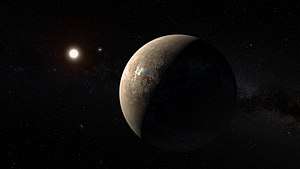 | ||
| Parent star | ||
| Star | Proxima Centauri | |
| Constellation | Centaurus | |
| Right ascension | (α) | 14h 29m 42.94853s |
| Declination | (δ) | −62° 40′ 46.1631″ |
| Apparent magnitude | (mV) | 11.13 |
| Distance | 4.224 ly (1.295[1] pc) | |
| Spectral type | M6Ve[2] | |
| Mass | (m) | 0.123 (± 0.006)[3] M☉ |
| Radius | (r) | 0.141 (± 0.007)[4] R☉ |
| Temperature | (T) | 3042 (± 117)[3] K |
| Metallicity | [Fe/H] | 0.21[5] |
| Age | 4.85[6] Gyr | |
| Physical characteristics | ||
| Minimum mass | (m sin i) | 1.27+0.19 −0.17[1] M⊕ |
| Radius | (r) | 0.8–1.5 [7] R⊕ |
| Stellar flux | (F⊙) | 0.65[1] ⊕ |
| Temperature | (T) | 234 K (−39 °C; −38 °F) |
| Orbital elements | ||
| Semi-major axis | (a) | 0.0485+0.0041 −0.0051[1] AU |
| Eccentricity | (e) | <0.35[1] |
| Orbital period | (P) | 11.186+0.001 −0.002[1] d |
| Argument of periastron |
(ω) | 310 (± 50)[1]° |
| Semi-amplitude | (K) | 1.38 (± 0.21)[1] m/s |
| Discovery information | ||
| Discovery date | 24 August 2016 | |
| Discoverer(s) | Anglada-Escudé (ca) et al. | |
| Discovery method | Doppler spectroscopy | |
| Discovery site | European Southern Observatory | |
| Discovery status | Confirmed | |
| Other designations | ||
Alpha Centauri Cb, Proxima b, GL 551 b, HIP 70890 b | ||
| Database references | ||
| Extrasolar Planets Encyclopaedia | data | |
| SIMBAD | data | |
| Exoplanet Archive | data | |
| Open Exoplanet Catalogue | data | |
Proxima Centauri b (also called Proxima b[8][9] or Alpha Centauri Cb) is an exoplanet orbiting in the habitable zone of the red dwarf star Proxima Centauri, which is the closest star to the Sun and part of a triple star system.[10][11] It is located about 4.2 light-years (1.3 parsecs, 40 trillion km, or 25 trillion miles) from Earth in the constellation of Centaurus, making it the closest known exoplanet to the Solar System.
Proxima Centauri b orbits the star at a distance of roughly 0.05 AU (7,500,000 km; 4,600,000 mi) with an orbital period of approximately 11.2 Earth days, and has an estimated mass of at least 1.3 times that of the Earth. Its habitability has not been established, though it is unlikely to be habitable since the planet is subject to stellar wind pressures of more than 2,000 times those experienced by Earth from the solar wind.[12][13][14]
The discovery of the planet was announced in August 2016 by the European Southern Observatory.[1][10] The planet was found using the radial velocity method, where periodic Doppler shifts of spectral lines of the host star suggest an orbiting object. From these readings, the radial velocity of the parent star relative to the Earth is varying with an amplitude of about 1.4 metres (4.5 feet) per second.[1] According to Guillem Anglada‐Escudé, its proximity to Earth offers an opportunity for robotic exploration of the planet with the Starshot project[10][11] or, at least, "in the coming centuries".[11]
Without the inclination of its orbit known, the exact mass of Proxima Centauri b is unknown. If its orbit is nearly edge-on, it would have a mass of 1.27+0.19
−0.17 Earth masses. Statistically, there is a roughly 90% chance that the planet's mass is less than 8.1+1.2
−1.0 Earth masses.
Characteristics
Mass, radius, and temperature
The apparent inclination of Proxima Centauri b's orbit has not yet been measured. The minimum mass of Proxima b is 1.27 M⊕, which would be the actual mass if its orbit were seen edge on from the Earth.[1] Once its orbital inclination is known, the mass will be calculable. More tilted orientations imply a higher mass, with 90% of possible orientations implying a mass below 3 M⊕.[15] The planet's exact radius is unknown. If it has a rocky composition and a density equal to that of the Earth, then its radius is at least 1.1 R⊕. It could be larger if it has a lower density than the Earth, or a mass higher than the minimum mass.[16] Like many super-Earth sized planets, Proxima Centauri b could have an icy composition like Neptune, with a thick layer of hydrogen on its surface; the likelihood that this is the case has been calculated to be greater than 10%.[7] The planet has an equilibrium temperature of 234 K (−39 °C; −38 °F).[1]
Host star
The planet orbits an M-type red dwarf named Proxima Centauri. The star has a mass of 0.12 M☉ and a radius of 0.14 R☉.[1] It has a surface temperature of 3042 K [3] and is 4.85 billion years old.[17] In comparison, the Sun is 4.6 billion years old [18] and has a surface temperature of 5778 K.[19] Proxima Centauri rotates once roughly every 83 days,[20] and has a luminosity about 0.0015 L☉.[1] Like the two larger stars in the triple star system, Proxima Centauri is rich in metals compared with the Sun, something not normally found in low-mass stars like Proxima. Its metallicity ([Fe/H]) is 0.21, or 1.62 times the amount found in the Sun's atmosphere.[5][note 1]
Even though Proxima Centauri is the closest star to the Sun, it is not visible to the unaided eye from Earth because of its low luminosity (apparent magnitude of 11.13[21]).
Proxima Centauri is a flare star.[22] This means that it undergoes occasional dramatic increases in brightness and high-energy emissions because of magnetic activity that would create large solar storms. On March 18, 2016 a superflare was observed with an energy of 10^33.5 erg [23]. The surface irradiation was estimated to be 100 times what is required to kill even UV-hardy microorganisms. Based on the rate of observed flares, total ozone depletion of an Earth-like atmosphere would occur within several hundred thousand years.
Orbit
Proxima Centauri b orbits its host star every 11.186 days at a semi-major axis distance of approximately 0.05 astronomical units (7,000,000 km; 5,000,000 mi), which means the distance from the exoplanet to its host star is one-twentieth of the distance from the Earth to the Sun.[1] Comparatively, Mercury, the closest planet to the Sun, has a semi-major axis distance of 0.39 AU. Proxima Centauri b receives about 65% of the amount of radiative flux from its host star that the Earth receives from the Sun - for comparison Mars receives about 43%. Most of the radiative flux from Proxima Centauri is in the infrared spectrum. In the visible spectrum the exoplanet receives only ~3% of the PAR (400-700 nm) of Earth irradiance - for comparison Jupiter receives 3.7% and Saturn 1.1%.[24] So it would usually not get much brighter than twilight anywhere on Proxima Centauri b's surface. The maximum illumination of horizontal ground by twilight at sunrise is about 400 lux,[25] while the illumination of Proxima b is about 2700 lux with quiet Proxima. Also, Proxima has flares. The brightest flare observed till 2016 had increased the visual brightness of Proxima about 8 times, which would be a large change from the previous level but, at about 17% the illumination of Earth, not very strong sunlight. [note 2] However, because of its tight orbit, Proxima Centauri b receives about 400 times more X-ray radiation than the Earth does.[1] According to a yet-to-be-published article, a March 2016 flare reached about 68 times usual level, thus a little brighter than the Sun.[26]
Habitability
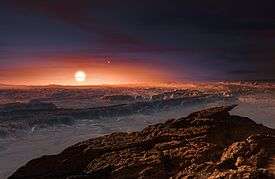
The habitability of Proxima Centauri b has not been established,[12][13] since the planet is subject to stellar wind pressures of more than 2,000 times those experienced by Earth from the solar wind.[12][27] This radiation and the stellar winds would likely blow any atmosphere away, leaving the undersurface as the only potentially habitable location on that planet.[28]
The exoplanet is orbiting within the habitable zone of Proxima Centauri, the region where, with the correct planetary conditions and atmospheric properties, liquid water may exist on the surface of the planet. The host star, with about an eighth of the mass of the Sun, has a habitable zone between ∼0.0423–0.0816 AU.[1] In October 2016, researchers at France's CNRS research institute stated that there is a considerable chance of the planet harboring surface oceans and having a thin atmosphere.[29] However, unless the planet transits in front of its star from the perspective of Earth, it is difficult to test these hypotheses.
Even though Proxima Centauri b is in the habitable zone, the planet's habitability has been questioned because of several potentially hazardous physical conditions. The exoplanet is close enough to its host star that it might be tidally locked.[30] In this case, it is expected that any habitable areas would be confined to the border region between the two extreme sides, generally referred to as the terminator line, since it is only here that temperatures might be suitable for liquid water to exist.[31] If the planet's orbital eccentricity is 0, this could result in synchronous rotation, with one hot side permanently facing towards the star, while the opposite side is in permanent darkness and freezing cold.[32][33] However, Proxima Centauri b's orbital eccentricity is not known with certainty, only that it is below 0.35—potentially high enough for it to have a significant chance of being captured into a 3:2 spin-orbit resonance similar to that of Mercury, where Proxima b would rotate around its axis approximately every 7.5 Earth days with about 22.4 Earth days elapsing between one sunrise and the next.[14][34][35] Resonances as high as 2:1 are also possible.[14][35]
The European Southern Observatory estimates that if water and an atmosphere are present, a far more hospitable environment would result. Assuming an atmospheric N2 pressure of 1 bar and ∼0.01 bar of CO2, in a world including oceans with average temperatures similar to those on Earth, a wide equatorial belt (non-synchronous rotation), or the majority of the sunlit side (synchronous rotation), would be permanently ice-free.[36][35] A large portion of the planet may be habitable if it has an atmosphere thick enough to transfer heat to the side facing away from the star.[31] If it has an atmosphere, simulations suggest that the planet could have lost about as much as the amount of water that Earth has due to the early irradiation in the first 100–200 million years after the planet's formation. Liquid water may be present only in the sunniest regions of the planet's surface in pools either in an area in the hemisphere of the planet facing the star or—if the planet is in a 3:2 resonance rotation—diurnally in the equatorial belt.[14][35] All in all, astrophysicists consider the ability of Proxima Centauri b to retain water from its formation as the most crucial point in evaluating the planet's present habitability.[37] The planet may be within reach of telescopes and techniques that could reveal more about its composition and atmosphere, if it has any.[12]
Formation
It is unlikely that Proxima Centauri b originally formed in its current orbit since disk models for small stars like Proxima Centauri would contain less than one Earth mass M⊕ of matter within the central one AU at the time of their formation. This implies that either Proxima Centauri b was formed elsewhere in a manner still to be determined, or the current disc models for stellar formation are in need of revision.[1]
Discovery
The first indications of the exoplanet were found in 2013 by Mikko Tuomi of the University of Hertfordshire from archival observation data.[20][38] To confirm the possible discovery, the European Southern Observatory launched the Pale Red Dot[note 3] project in January 2016.[39] On 24 August 2016 the team of 31 scientists from all around the world,[40] led by Guillem Anglada-Escudé of Queen Mary University of London, confirmed the existence of Proxima Centauri b[17] through their research, published in a peer-reviewed article in Nature.[41][1][30][42][43][44]
The measurements were done using two spectrographs, HARPS on the ESO 3.6 m Telescope at La Silla Observatory and UVES on the 8-metre Very Large Telescope.[1] The peak radial velocity of the host star combined with the orbital period allowed for the minimum mass of the exoplanet to be calculated. The chance of a false positive detection is less than one in ten million.[20]
Observational complications of the system still leave theoretical room for additional large planets to orbit Proxima Centauri. Calculations suggest that another super-Earth planet around the star cannot be ruled out and that its presence would not destabilize the orbit of Proxima Centauri b.[1]
Future observations

A team of scientists think they can image Proxima Centauri b and probe the planet's atmosphere for signs of oxygen, water vapor, and methane, combining ESPRESSO and SPHERE on the VLT.[46] The James Webb Space Telescope may be able to characterize the atmosphere of Proxima Centauri b,[47] but there is no conclusive evidence for transits combining MOST and HATSouth photometry, giving it less than a 1 percent chance of being a transiting planet.[48] Future telescopes (the Extremely Large Telescope, the Giant Magellan Telescope, and the Thirty Meter Telescope) could have the capability to characterize Proxima Centauri b.
The discovery of Proxima b was significant to Breakthrough Starshot, a proof of concept project aiming to send a fleet of miniature probes to the Alpha Centauri system.[49] The project is led by research company Breakthrough Initiatives, and plans to develop and launch a fleet of miniature unmanned spacecraft called StarChips,[50] which could travel at up to 20% of the speed of light,[51][52] arriving at the system in roughly 20 years with notification reaching Earth a little over 4 years later.[10]
2069 Alpha Centauri mission
In 2017, Breakthrough Initiatives and the European Southern Observatory (ESO) entered a collaboration to enable and implement a search for habitable planets in the nearby star system, Alpha Centauri. The agreement involves Breakthrough Initiatives providing funding for an upgrade to the VISIR (VLT Imager and Spectrometer for mid-Infrared) instrument on ESO’s Very Large Telescope (VLT) in Chile.[45]
Gallery

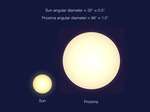
.tif.jpg)
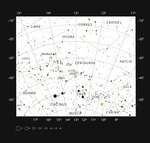
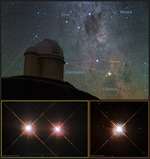
Videos
See also
- Astrobiology
- Breakthrough Starshot
- Exoplanetology
- List of potentially habitable exoplanets
- Colossus Telescope
- Alpha Centauri Bb – exoplanet once proposed to be orbiting the secondary star of the system, Alpha Centauri B, and was dubbed the closest exoplanet for a while before being disproven
Notes
- ↑ Taken from 100.21, which gives 1.62 times the metallicity of the Sun
- ↑ From knowing the absolute visual magnitude of Proxima Centauri, , and the absolute visual magnitude of the Sun, , the visual luminosity of Proxima Centauri can be calculated: = 4.92×10−5. Proxima Centauri b orbits at 0.0485 AU and so therefore, through use of the inverse-square law, the visual luminosity—intensity at the planet's distance—can be calculated:
- ↑ Pale Red Dot is a reference to Pale Blue Dot—a distant photo of Earth taken by Voyager 1.
References
- 1 2 3 4 5 6 7 8 9 10 11 12 13 14 15 16 17 18 19 20 21 Anglada-Escudé, G.; Amado, P. J.; Barnes, J.; Berdiñas, Z. M.; Butler, R. P.; Coleman, G. A. L.; de la Cueva, I.; Dreizler, S.; Endl, M.; Giesers, B.; Jeffers, S. V.; Jenkins, J. S.; Jones, H. R. A.; Kiraga, M.; Kürster, M.; López-González, M. J.; Marvin, C. J.; Morales, N.; Morin, J.; Nelson, R. P.; Ortiz, J. L.; Ofir, A.; Paardekooper, S.-J.; Reiners, A.; Rodríguez, E.; Rodrίguez-López, C.; Sarmiento, L. F.; Strachan, J. P.; Tsapras, Y.; Tuomi, M.; Zechmeister, M. (25 August 2016). "A terrestrial planet candidate in a temperate orbit around Proxima Centauri" (PDF). Nature. 536 (7617): 437–440. arXiv:1609.03449. Bibcode:2016Natur.536..437A. doi:10.1038/nature19106. ISSN 0028-0836. PMID 27558064.
- ↑ Torres, C. A. O.; Quast, G. R.; Da Silva, L.; De La Reza, R.; Melo, C. H. F.; Sterzik, M. (December 2006). "Search for associations containing young stars (SACY). I. Sample and searching method". Astronomy and Astrophysics. 460 (3): 695–708. arXiv:astro-ph/0609258. Bibcode:2006A&A...460..695T. doi:10.1051/0004-6361:20065602.
- 1 2 3 Ségransan, D.; Kervella, P.; Forveille, T.; Queloz, D. (2003). "First radius measurements of very low mass stars with the VLTI". Astronomy and Astrophysics. 397 (3): L5–L8. arXiv:astro-ph/0211647. Bibcode:2003A&A...397L...5S. doi:10.1051/0004-6361:20021714.
- ↑ Demory, B.-O.; Ségransan, D.; Forveille, T.; Queloz, D.; Beuzit, J.-L.; Delfosse, X.; Di Folco, E.; Kervella, P.; Le Bouquin, J.-B. (October 2009). "Mass-radius relation of low and very low-mass stars revisited with the VLTI". Astronomy and Astrophysics. 505 (1): 205–215. arXiv:0906.0602. Bibcode:2009A&A...505..205D. doi:10.1051/0004-6361/200911976.
- 1 2 Schlaufman, K. C.; Laughlin, G. (September 2010). "A physically-motivated photometric calibration of M dwarf metallicity". Astronomy and Astrophysics. 519: A105. arXiv:1006.2850. Bibcode:2010A&A...519A.105S. doi:10.1051/0004-6361/201015016.
- ↑ Kervella, Pierre; Thevenin, Frederic (15 March 2003). "A family portrait of the Alpha Centauri system: VLT interferometer studies the nearest stars". ESO. Retrieved 5 September 2016.
- 1 2 Bixel, A.; Apai, D. (21 February 2017). "Probabilistic Constraints on the Mass and Composition of Proxima b". The Astrophysical Journal Letters. 836 (2): L31. Bibcode:2017ApJ...836L..31W. doi:10.3847/2041-8213/aa5f51. ISSN 2041-8205.
- ↑ "Earth-like planet discovered orbiting sun's neighbor". CNN. 24 August 2016. Retrieved 24 August 2016.
A planet named Proxima b has been discovered orbiting the closest star to our sun.
- ↑ Davis, Nicola (24 August 2016). "Discovery of potentially Earth-like planet Proxima b raises hopes for life". The Guardian. Retrieved 24 August 2016.
- 1 2 3 4 Chang, Kenneth (24 August 2016). "One Star Over, a Planet That Might Be Another Earth". New York Times. Retrieved 24 August 2016.
- 1 2 3 Strickland, Ashley (24 August 2016). "Closest potentially habitable planet to our solar system found". CNN Health. Retrieved 25 August 2016.
- 1 2 3 4 Clery, Daniel (26 August 2016). "The exoplanet next door". Science News. Retrieved 28 August 2016.
Researchers have already found hundreds of similarly sized planets, and many appear to be far better candidates for hosting life than the one around Proxima Centauri, called Proxima b.
- 1 2 Amos, Jonathan (24 August 2016). "Neighbouring star Proxima Centauri has Earth-sized planet". BBC News. Retrieved 25 August 2016.
Just how "habitable" this particular planet really is, one has to say is pure speculation for the time being.
- 1 2 3 4 Ribas, Ignasi; Bolmont, Emeline; Selsis, Franck; et al. (25 August 2016). "The habitability of Proxima Centauri b: I. Irradiation, rotation and volatile inventory from formation to the present". Astronomy & Astrophysics. 596: A111. arXiv:1608.06813 [astro-ph.EP]. Bibcode:2016A&A...596A.111R. doi:10.1051/0004-6361/201629576. Cite uses deprecated parameter
|class=(help) - ↑ Marchis, Franck (24 August 2016). "Proxima Centauri b: Have we just found Earth's cousin right on our doorstep?". The Planetary Society. Retrieved 24 August 2016.
- ↑ A Potentially Habitable World in Our Nearest Star. Planetary Habitability Laboratory. 24 August 2016.
- 1 2 Mathewson, Samantha (24 August 2016). "Proxima b By the Numbers: Possibly Earth-Like World at the Next Star Over". Space.com. Retrieved 25 August 2016.
- ↑ Fraser Cain (16 September 2008). "How Old is the Sun?". Universe Today. Retrieved 19 February 2011.
- ↑ Fraser Cain (15 September 2008). "Temperature of the Sun". Universe Today. Retrieved 19 February 2011.
- 1 2 3 "Proxima b is our neighbor ... better get used to it!". Pale Red Dot. 24 August 2016. Retrieved 24 August 2016.
- ↑ Jao, Wei-Chun; Henry, Todd J.; Subasavage, John P.; Winters, Jennifer G.; Gies, Douglas R.; Riedel, Adric R.; Ianna, Philip A. (2014). "The Solar Neighborhood. XXXI. Discovery of an Unusual Red+White Dwarf Binary at ~25 pc via Astrometry and UV Imaging". The Astronomical Journal. 147 (1): 21. arXiv:1310.4746. Bibcode:2014AJ....147...21J. doi:10.1088/0004-6256/147/1/21. ISSN 0004-6256.
- ↑ Christian, D. J.; Mathioudakis, M.; Bloomfield, D. S.; Dupuis, J.; Keenan, F. P. (2004). "A Detailed Study of Opacity in the Upper Atmosphere of Proxima Centauri". The Astrophysical Journal. 612 (2): 1140–1146. Bibcode:2004ApJ...612.1140C. doi:10.1086/422803.
- ↑ https://www.universetoday.com/138980/proxima-centauri-just-released-a-flare-so-powerful-it-was-visible-to-the-unaided-eye-planets-there-would-get-scorched-1/
- ↑ Ritchie, Raymond J.; Larkum, Anthony W. D.; Ribas, Ignasi (April 2018). "Could photosynthesis function on Proxima Centauri b?". International Journal of Astrobiology. 17 (2): 147–176. Bibcode:2018IJAsB..17..147R. doi:10.1017/S1473550417000167. Retrieved 2018-09-10.
- ↑ Schlyter, Paul (2017-03-05). "Radiometry and photometry in astronomy". stjarnhimlen.se. Stockholm, Sweden. 10: How bright are natural light sources?. Retrieved 2017-06-21.
- ↑ Howard, Ward S; Tilley, Matt A; Corbett, Hank; Youngblood, Allison; Parke Loyd, R. O; Ratzloff, Jeffrey K; Fors, Octavi; Daniel del Ser; Shkolnik, Evgenya L; Ziegler, Carl; Goeke, Erin E; Pietraallo, Aaron D; Haislip, Joshua; Law, Nicholas M (2018). "The First Naked-Eye Superflare Detected from Proxima Centauri". arXiv:1804.02001 [astro-ph.EP].
- ↑ Garraffo, Cecilia; Drake, Jeremy J.; Cohen, Ofer (28 September 2016). "The Space Weather of Proxima Centauri b". The Astrophysical Journal. 833: L4. arXiv:1609.09076 [astro-ph.SR]. Bibcode:2016ApJ...833L...4G. doi:10.3847/2041-8205/833/1/L4. Cite uses deprecated parameter
|class=(help) - ↑ O'Neill, Ian (7 October 2016). "Eyeballing Proxima b: Probably Not a Second Earth". Discovery News. Space.com. Retrieved 2016-10-10.
- ↑ "Planet in star system nearest our Sun 'may have oceans'", Phys.org, Retrieved 6 October 2016
- 1 2 Witze, Alexandra (24 August 2016). "Earth-sized planet around nearby star is astronomy dream come true". Nature. pp. 381–382. Bibcode:2016Natur.536..381W. doi:10.1038/nature.2016.20445. Retrieved 24 August 2016.
- 1 2 Singal, Ashok K. (2014). "Life on a tidally-locked planet". Planex Newsletter. 4 (2): 8. arXiv:1405.1025. Bibcode:2014arXiv1405.1025S.
- ↑ Barnes, Rory, ed. (2010), Formation and Evolution of Exoplanets, John Wiley & Sons, p. 248, ISBN 3527408967.
- ↑ Heller, R.; Leconte, J.; Barnes, R. (April 2011). "Tidal obliquity evolution of potentially habitable planets". Astronomy & Astrophysics. 528: 16. arXiv:1101.2156. Bibcode:2011A&A...528A..27H. doi:10.1051/0004-6361/201015809. A27.
- ↑ Makarov, Valeri V. (June 2012), "Conditions of Passage and Entrapment of Terrestrial Planets in Spin-orbit Resonances", The Astrophysical Journal, 752 (1): 8, arXiv:1110.2658, Bibcode:2012ApJ...752...73M, doi:10.1088/0004-637X/752/1/73, 73.
- 1 2 3 4 The habitability of Proxima Centauri b - II. Possible climates and observability. Retrieved 25 August 2016.
- ↑ "Numerical simulation of possible surface temperatures on Proxima b (synchronous rotation)". ESO. 2016. Retrieved 24 August 2016.
- ↑ Barnes, Rory (24 August 2016). "The Habitability of Proxima Centauri b I: Evolutionary Scenarios". Astrobiology. 1608: 62. arXiv:1608.06919. Bibcode:2016arXiv160806919B.
- ↑ Aron, Jacob. 24 August 2016. Proxima b: Closest Earth-like planet discovered right next door. New Scientist. Retrieved 24 August 2016.
- ↑ "Follow a Live Planet Hunt!". European Southern Observatory. 15 January 2016. Retrieved 24 August 2016.
- ↑ Feltman, Rachel (August 24, 2016). "Scientists say they've found a planet orbiting Proxima Centauri, our closest neighbor". The Washington Post – via GALE.
- ↑ "Planet Found in Habitable Zone Around Nearest Star - Pale Red Dot campaign reveals Earth-mass world in orbit around Proxima Centauri". www.eso.org. Retrieved 10 January 2017.
- ↑ "Planet Found in Habitable Zone Around Nearest Star". European Southern Observatory. 24 August 2016.
- ↑ "Found! Potentially Earth-Like Planet at Proxima Centauri Is Closest Ever". Space.com. 24 August 2016.
- ↑ Knapton, Sarah (24 August 2016). "Proxima b: Alien life could exist on 'second Earth' found orbiting our nearest star in Alpha Centauri system". The Telegraph. Telegraph Media Group. Retrieved 24 August 2016.
- 1 2 "VLT to Search for Planets in Alpha Centauri System - ESO Signs Agreement with Breakthrough Initiatives". www.eso.org. Retrieved 10 January 2017.
- ↑ Lovis, C.; Snellen, I.; Mouillet, D.; Pepe, F.; Wildi, F.; Astudillo-Defru, N.; Beuzit, J. -L.; Bonfils, X.; Cheetham, A.; Conod, U.; Delfosse, X.; Ehrenreich, D.; Figueira, P.; Forveille, T.; Martins, J. H. C.; Quanz, S.; Santos, N. C.; Schmid, H. -M.; Ségransan, D.; Udry, S. (2016). "Atmospheric characterization of Proxima b by coupling the SPHERE high-contrast imager to the ESPRESSO spectrograph". Astronomy & Astrophysics. 599: A16. arXiv:1609.03082 [astro-ph.EP]. Bibcode:2017A&A...599A..16L. doi:10.1051/0004-6361/201629682. Cite uses deprecated parameter
|class=(help) - ↑ Kreidberg, Laura; Loeb, Abraham (2016). "Prospects for Characterizing the Atmosphere of Proxima Centauri b". The Astrophysical Journal. 832: L12. arXiv:1608.07345 [astro-ph.EP]. Bibcode:2016ApJ...832L..12K. doi:10.3847/2041-8205/832/1/L12. Cite uses deprecated parameter
|class=(help) - ↑ Kipping, David M.; et al. (2017). "No Conclusive Evidence for Transits of Proxima b in MOST photometry". The Astronomical Journal. 153 (3): 93. arXiv:1609.08718. Bibcode:2017AJ....153...93K. doi:10.3847/1538-3881/153/3/93.
- ↑ Staff (12 April 2016). "Starshot". Breakthrough Initiatives. Retrieved 12 April 2016.
- ↑ Gilster, Paul (12 April 2016). "Breakthrough Starshot: Mission to Alpha Centauri". Centauri Dreams. Retrieved 14 April 2016.
- ↑ Overbye, Dennis (12 April 2016). "Reaching for the Stars, Across 4.37 Light-Years; A Visionary Project Aims for Alpha Centauri, a Star 4.37 Light-Years Away". New York Times. Retrieved 12 April 2016.
- ↑ Stone, Maddie (April 12, 2016). "Stephen Hawking and a Russian Billionaire Want to Build an Interstellar Starship". Gizmodo. Retrieved 12 April 2016.
Further reading
- Calandrelli E, Escher A (16 December 2016). "The top 15 events that happened in space in 2016". TechCrunch. Retrieved 2016-12-16.
External links
| Wikimedia Commons has media related to Proxima Centauri b. |

.jpg)